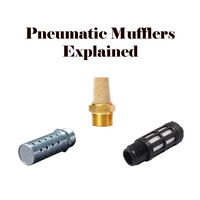
Item # PNEUMATIC MUFFLERS EXPLAINED
WHAT ARE THE DIFFERENCES BETWEEN PNEUMATC MUFFLERS
- UM : EA
What are the differences between pneumatic mufflers?
When choosing a pneumatic muffler for your application, there are several options to consider, each with its own set of advantages and disadvantages. Pneumatic mufflers are typically used to reduce the noise generated by the exhaust of compressed air in pneumatic systems. They are also referred to as pneumatic silencers.
Breather Vents-allow air to flow in and out of an enclosed space, such as a gearbox, oil tank, or reservoir where varying liquid levels or mechanical action can create an extreme high or low pressure environment, which can damage expensive pneumatic system components. Breather vents have a screened opening to equalize pressure while preventing large particle contamination, also smoothing airflow to help reduce noise.
These mufflers are utilized for:
- Vacuum relief and overpressure protection
- Noise reduction
- Prevention of contamination
Advantages: Low profile, low cost, low flow restriction
Disadvantages: Poor noise reduction, poor air filtration
Sintered Bronze Mufflers-are made of sintered bronze, a porous material that allows air to pass through while smoothing air flow over a greater surface area, reducing the noise level. Sintered bronze mufflers also provide filtering to prevent contaminants from entering an air system. When used on exhaust ports, they can help prevent oil mist from lubricated air sources from contaminating clean environments. Sintered bronze mufflers also provide a small amount of flow restriction to exhaust ports, helping to fine tune actuator speeds.
These mufflers are utilized for:
- Pneumatic equipment noise reduction
- Exhaust and intake port protection
- Flow regulation
Advantages: Low profile, low cost, high temperature tolerance
Disadvantages: Moderate noise reduction, poor air filtration
Metal Mufflers-are installed directly into the exhaust port of pneumatic valves and equipment. They work by diffusing the released air through a series of drilled baffles and screens which create a larger surface area, reducing turbulence and decreasing noise level. Metal mufflers can handle high volumes of high pressure air due to their durable construction and provide a small amount of flow restriction that can be useful in fine tuning actuator cycle times.
These mufflers are utilized for:
- Air valves, especially quick exhaust valves
- Cylinders
- Manifolds
- Washdown areas
Advantages: Robust, good noise reduction, moderate air filtration
Disadvantages: High cost, larger size
Plastic Mufflers-have either injection-molded or sintered plastic bodies with plastic fibers, sintered plastic, or metal powder as the noise-reducing medium. They can be made of various resins, such as polyethylene, to provide resistance to most common chemicals and can be tuned to attenuate specific frequencies of sound- i.e. high frequencies from rotary or impact tools. Plastic mufflers can provide good noise reduction for enclosed areas or areas where pneumatic exhaust noise must be kept to a minimum. They can also filter exhaust air to help prevent lubrication oil mist from contaminating clean environments. Plastic mufflers are best used in semi-protected areas, as they are more prone to damage than sintered bronze or metal mufflers.
These mufflers are utilized for:
- Vacuum pumps
- Small compressors
- Pneumatic valves
- Air motors
- Rotary/Impact air tools
Advantages: Good noise reduction, moderate air filtration, low cost, lightweight, high chemical resistance
Disadvantages: Not very robust
Speed Control Mufflers-can help control the speed of a pneumatic actuator by varying the restriction of air flow through the exhaust port. Quality speed control mufflers use a lock nut to help preserve the restriction setting that provides optimum actuator speed. Speed control mufflers are typically of sintered bronze or metal construction.
This type of muffler is utilized for:
- Valves
- Cylinders
- Air Tools
Advantages: Combines noise reduction with speed control
Disadvantage: Speed control can be inconsistent
It is important to choose the right muffler for your pneumatic application. Considering the advantages and disadvantages of each type prior to purchase can save cost and frustration over time.
NOT FINDING WHAT YOU NEED?
SEND US AN E-MAIL:
SALES@THEPNEUMATICSTORE.COM
Specifications
| ARTICLES REGUARDING | AUTOMATION COMPONENTS |

